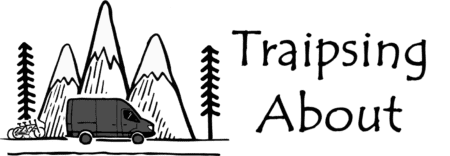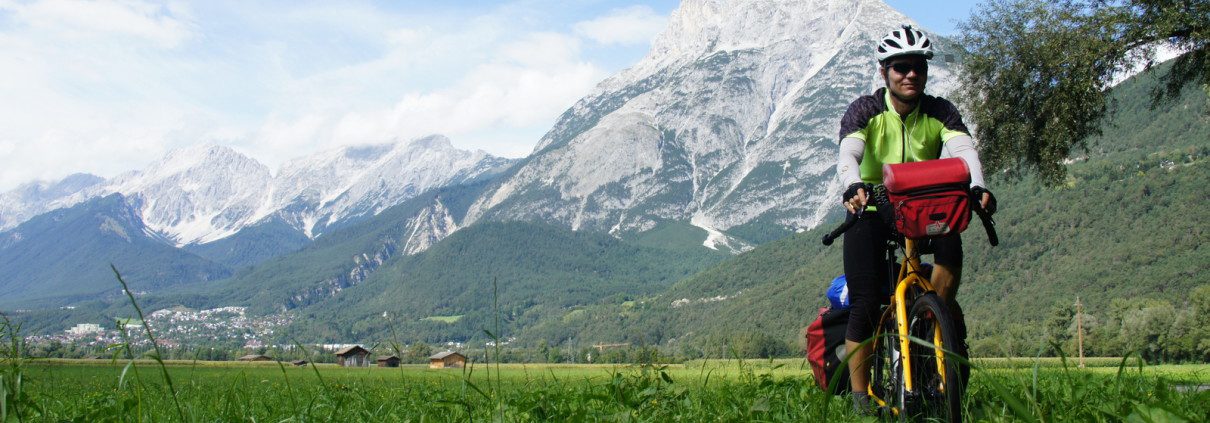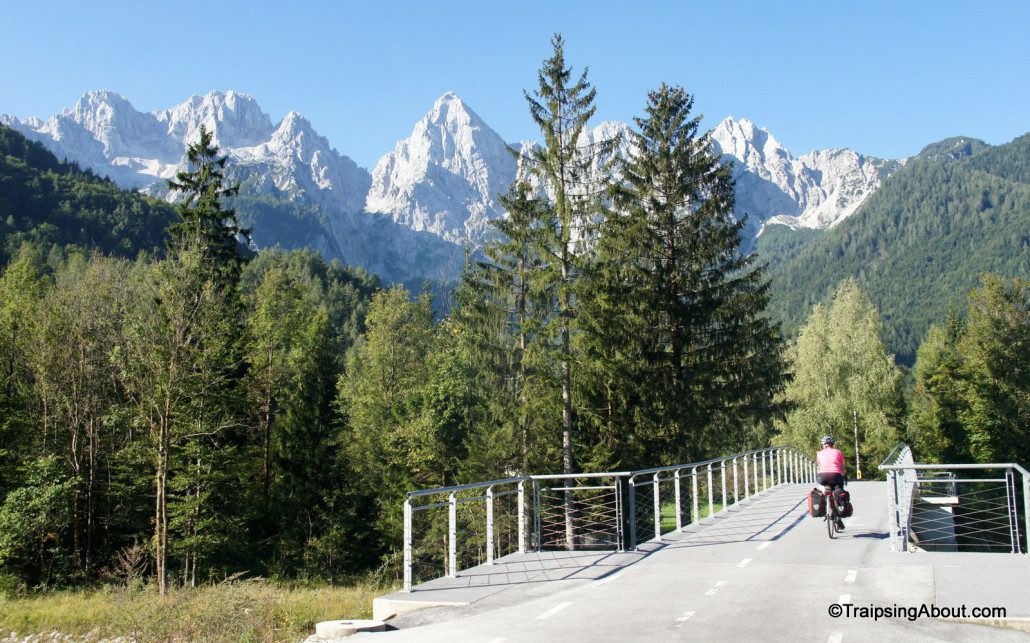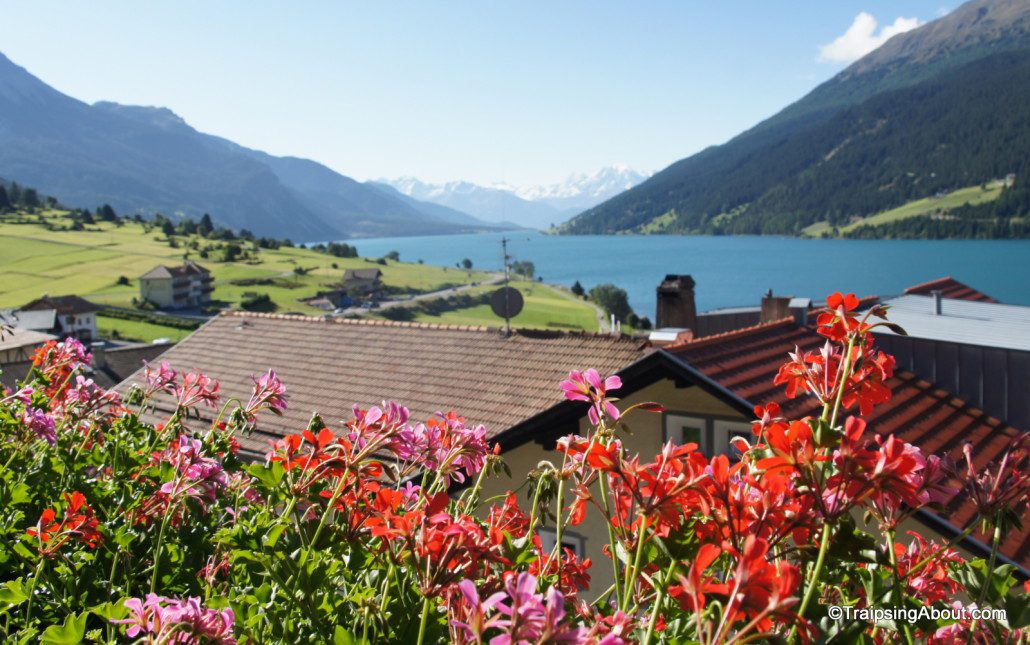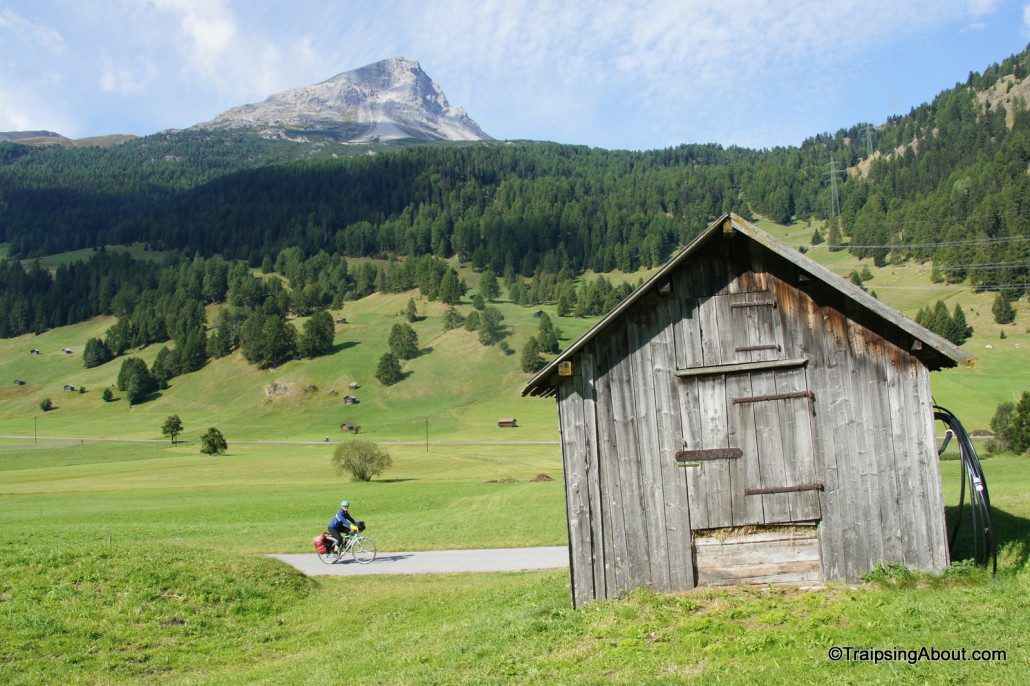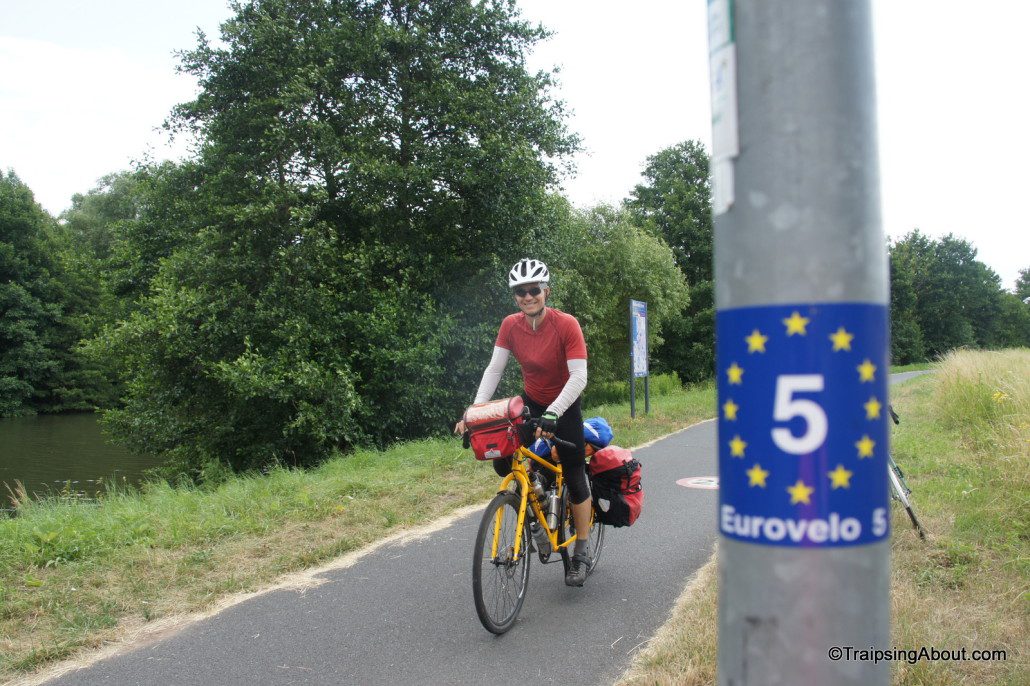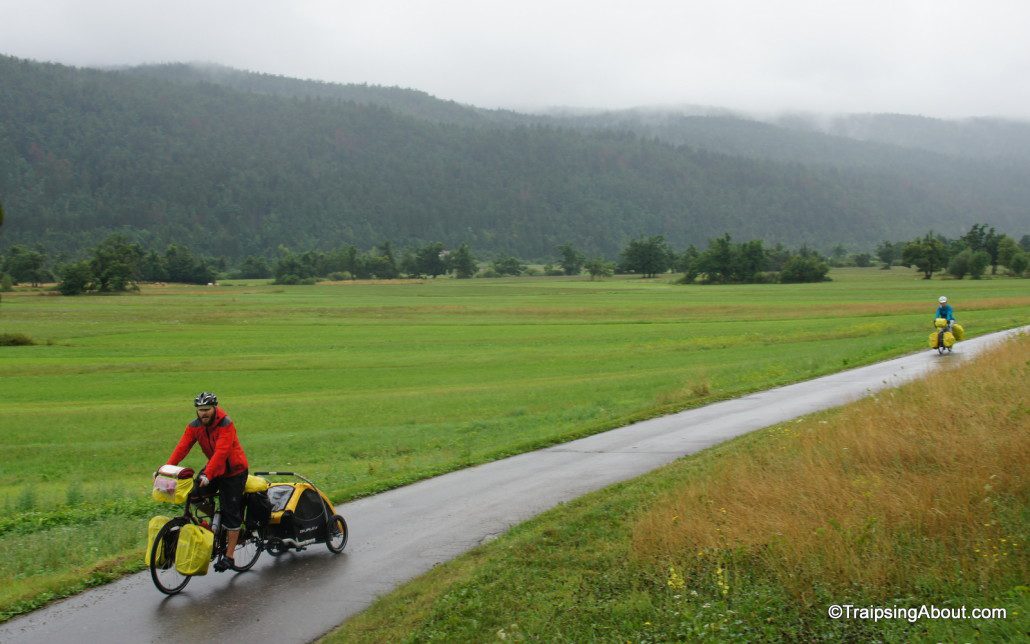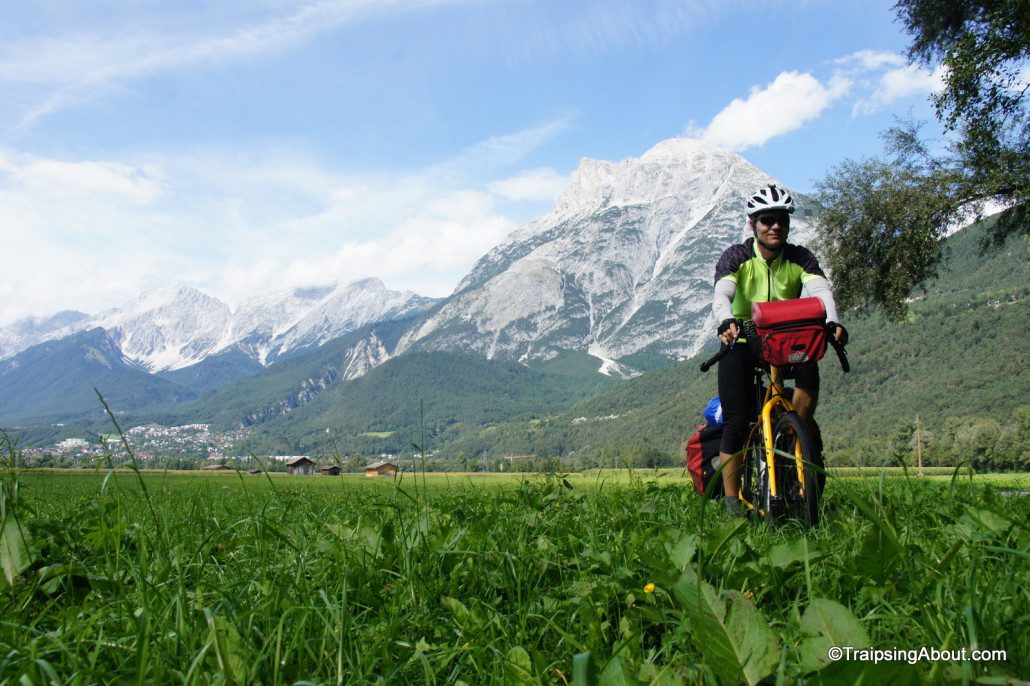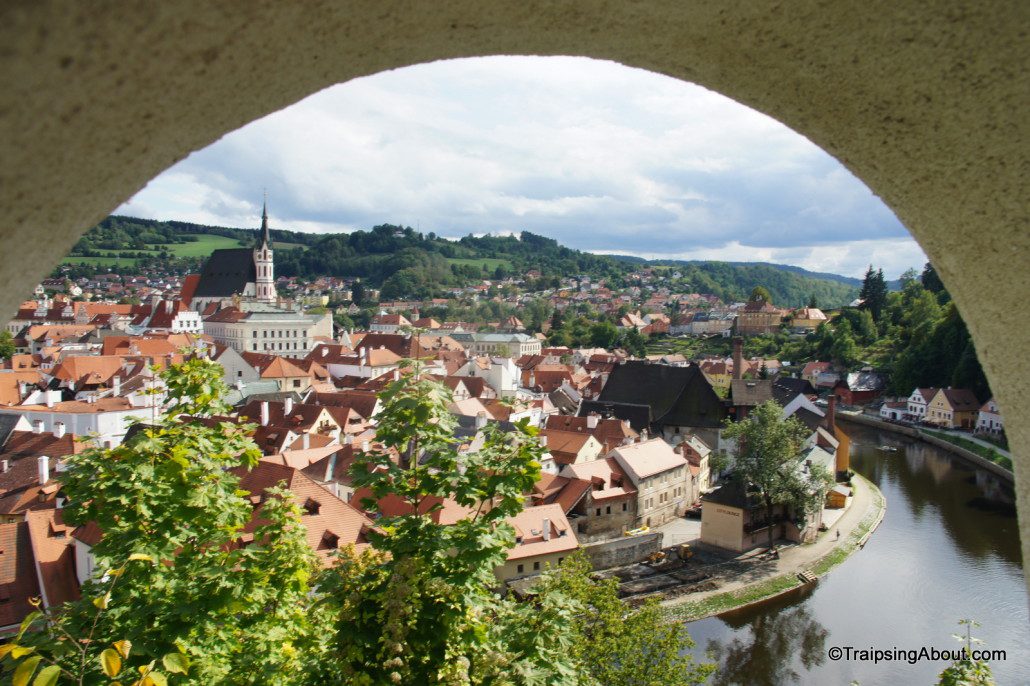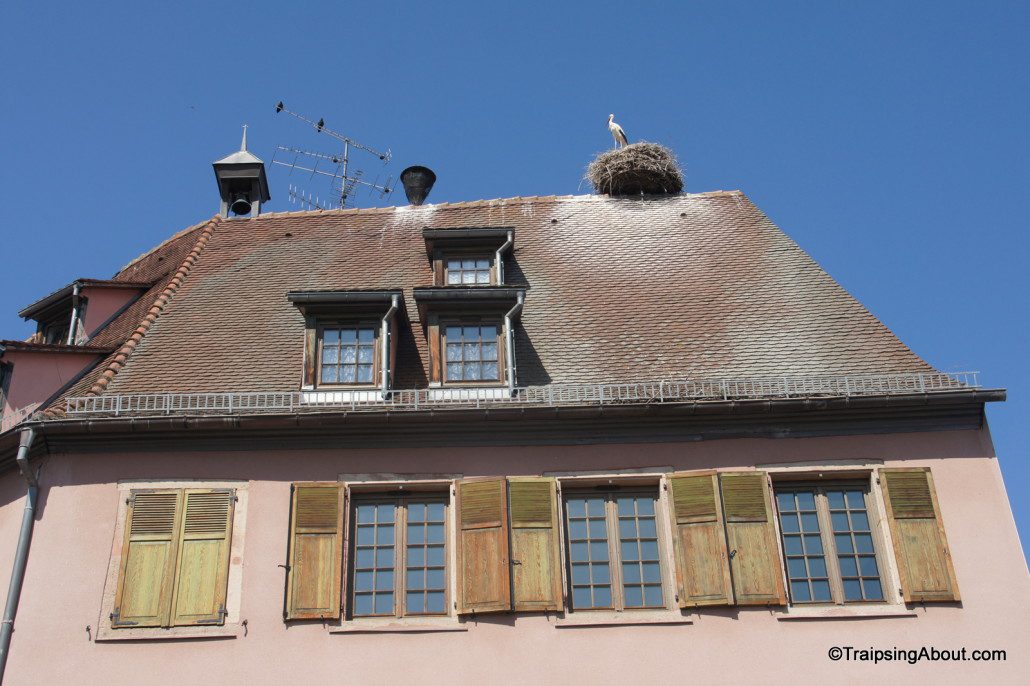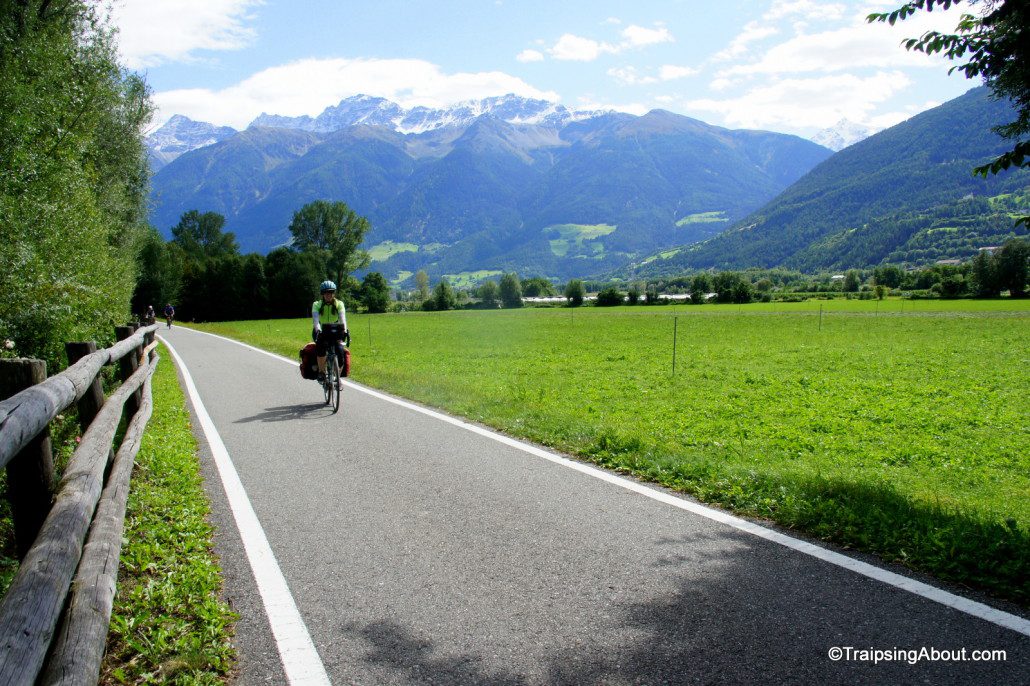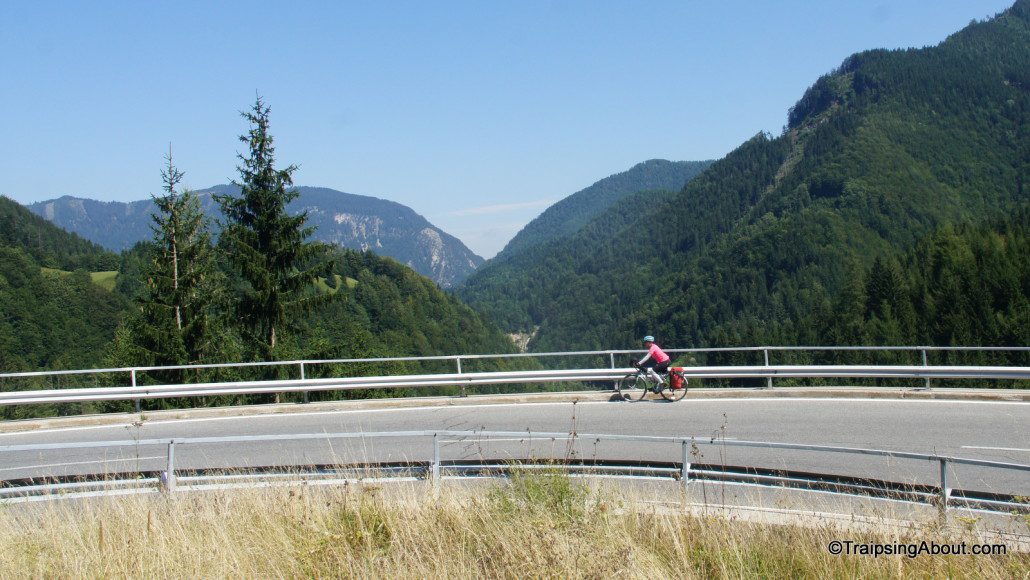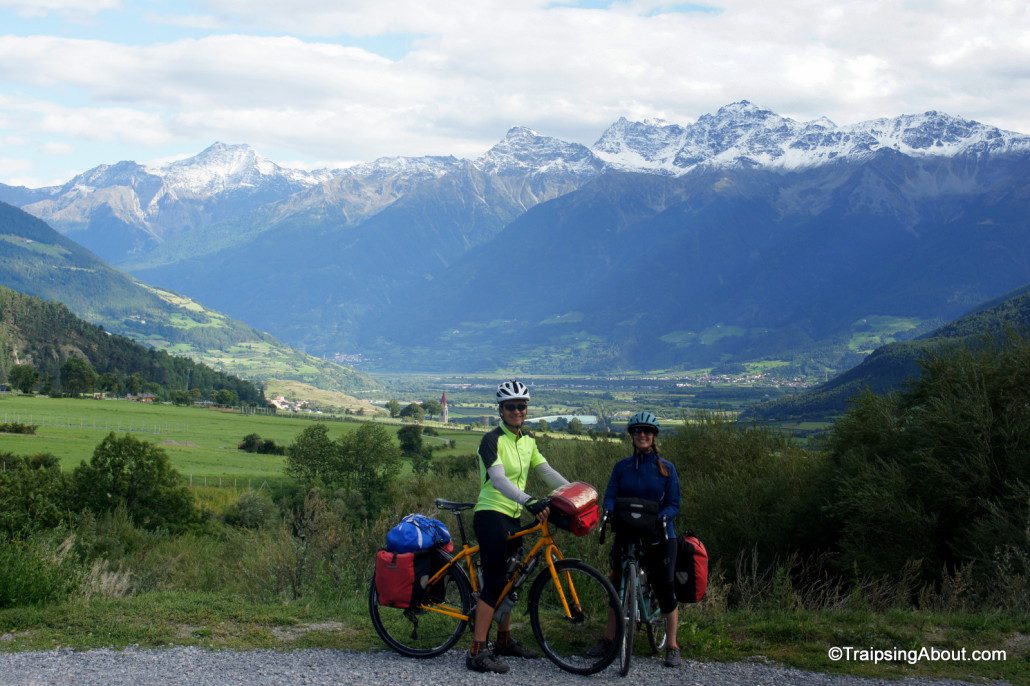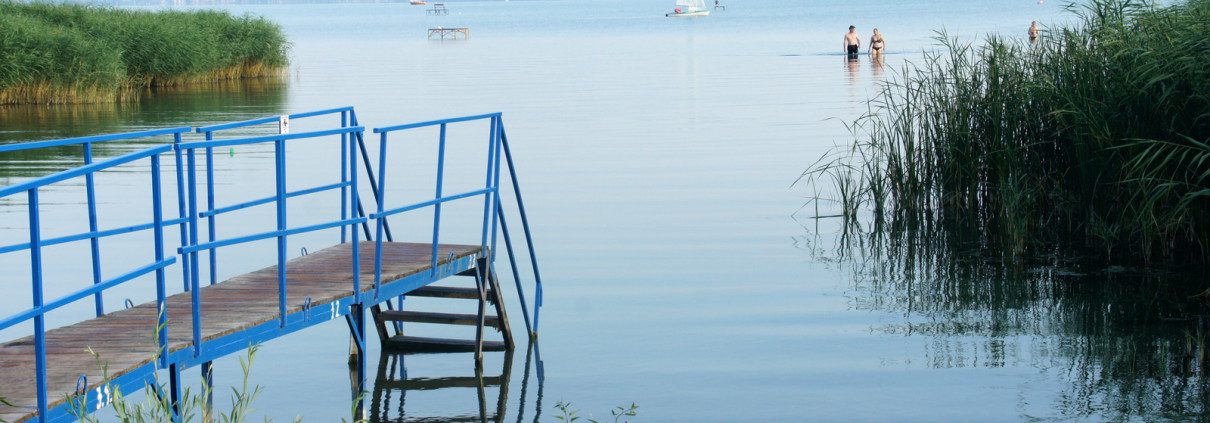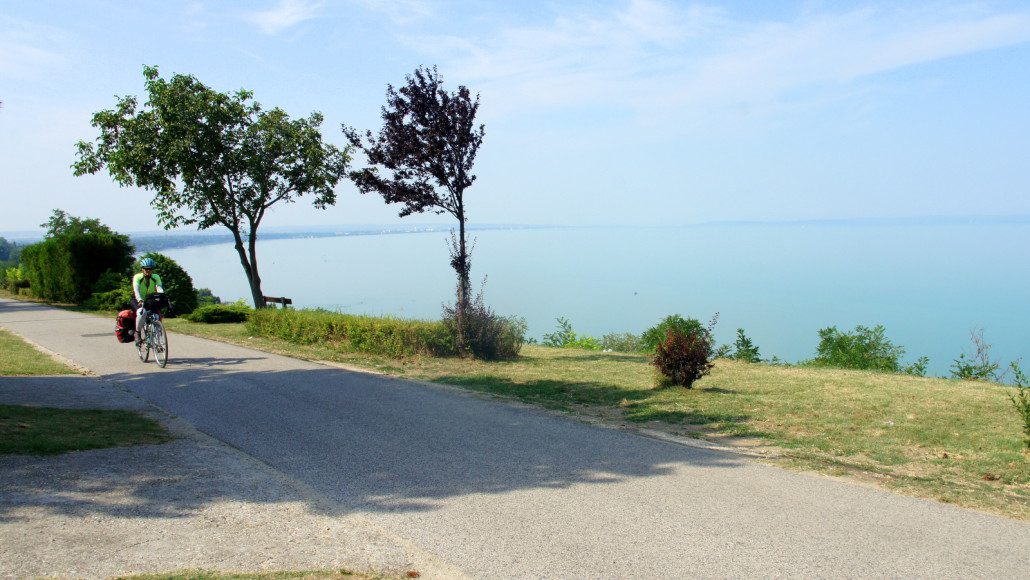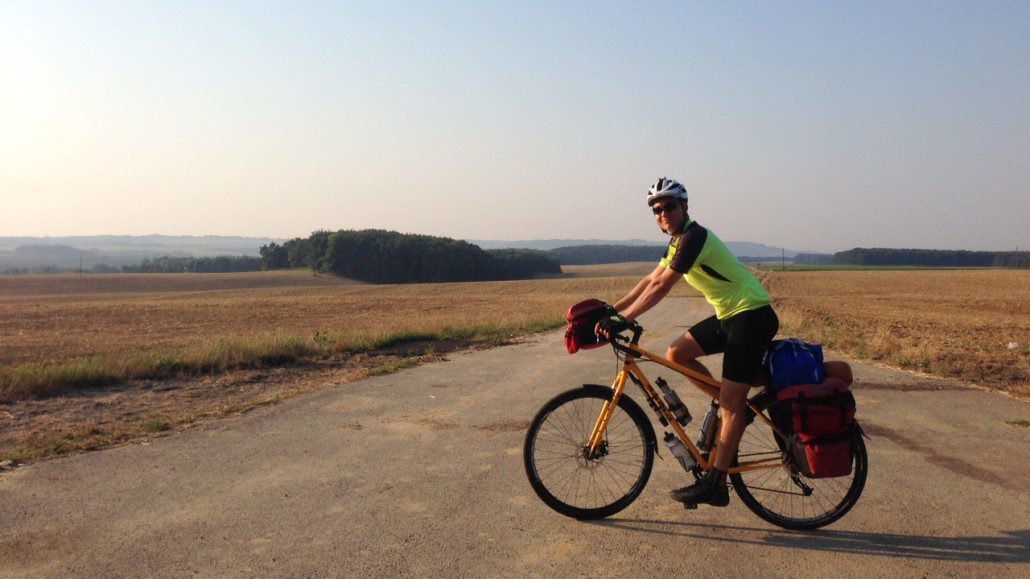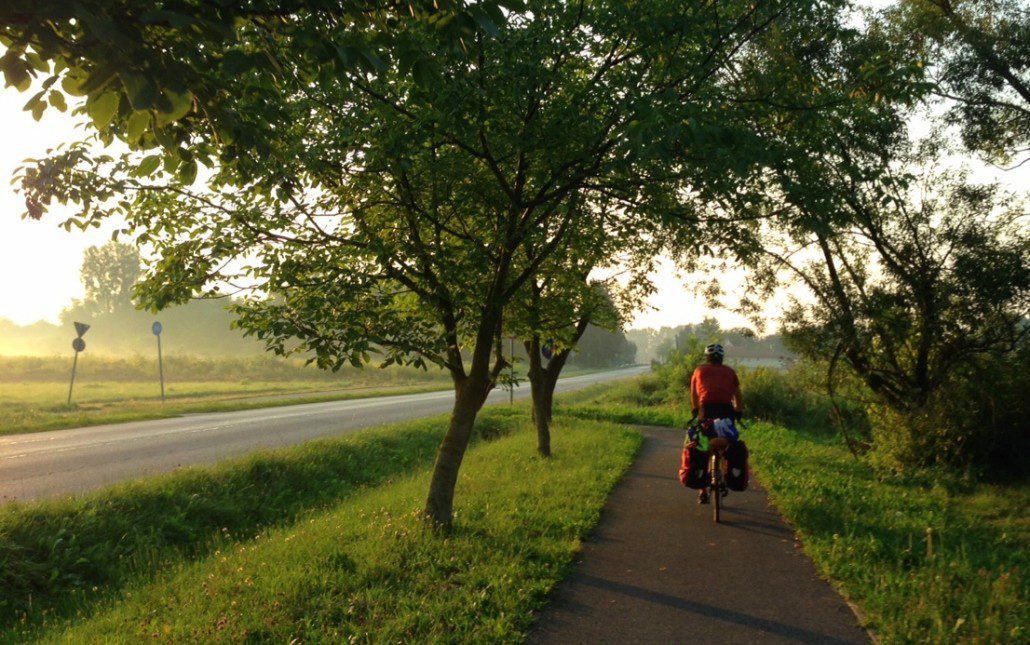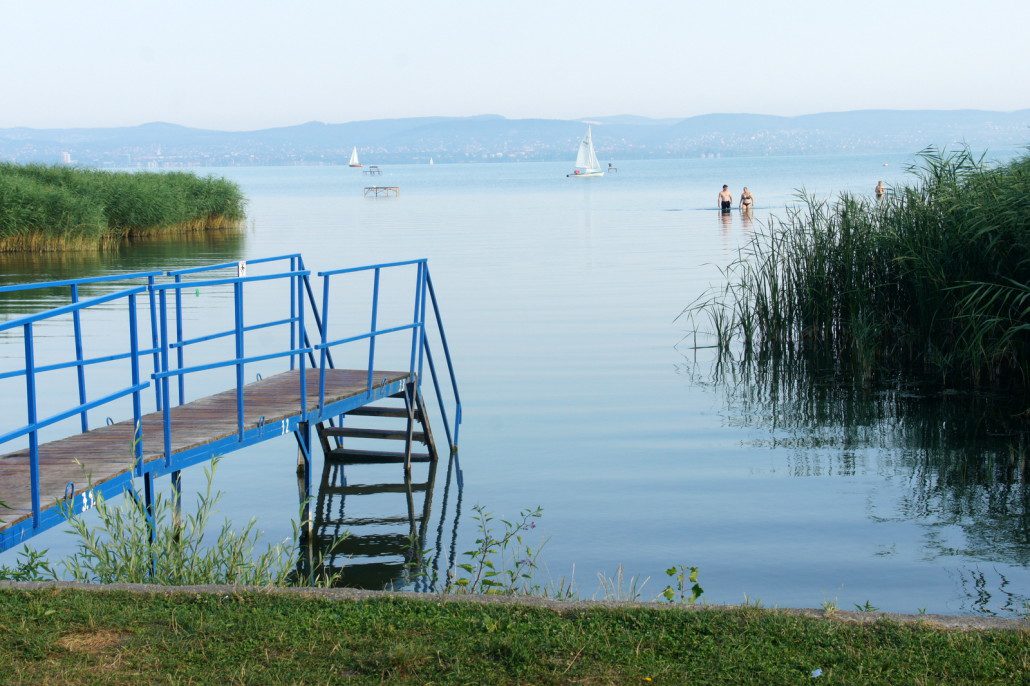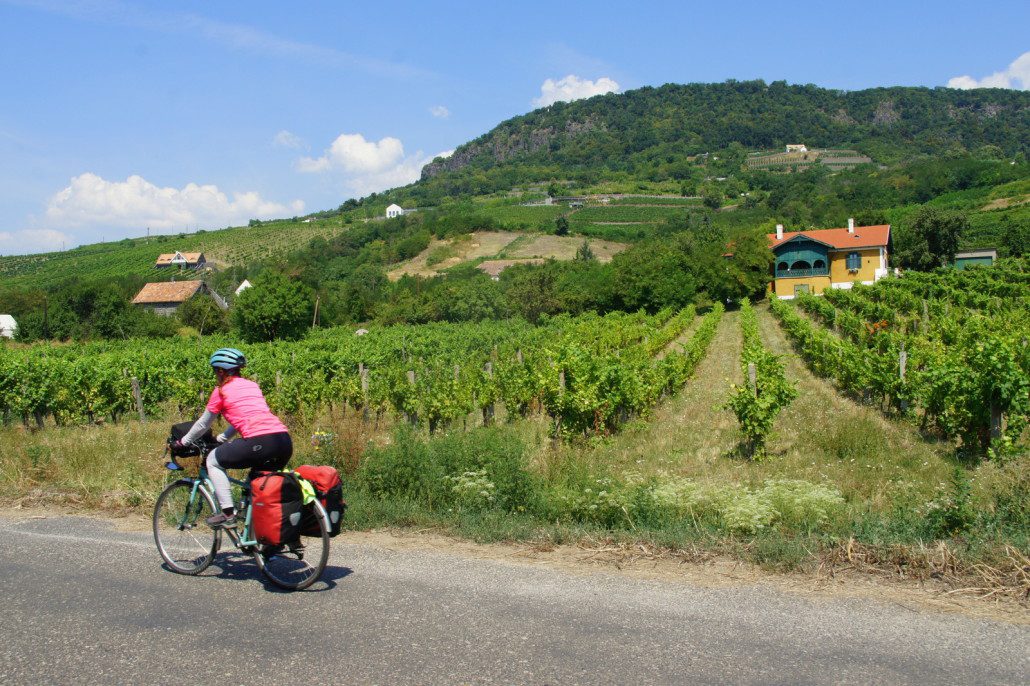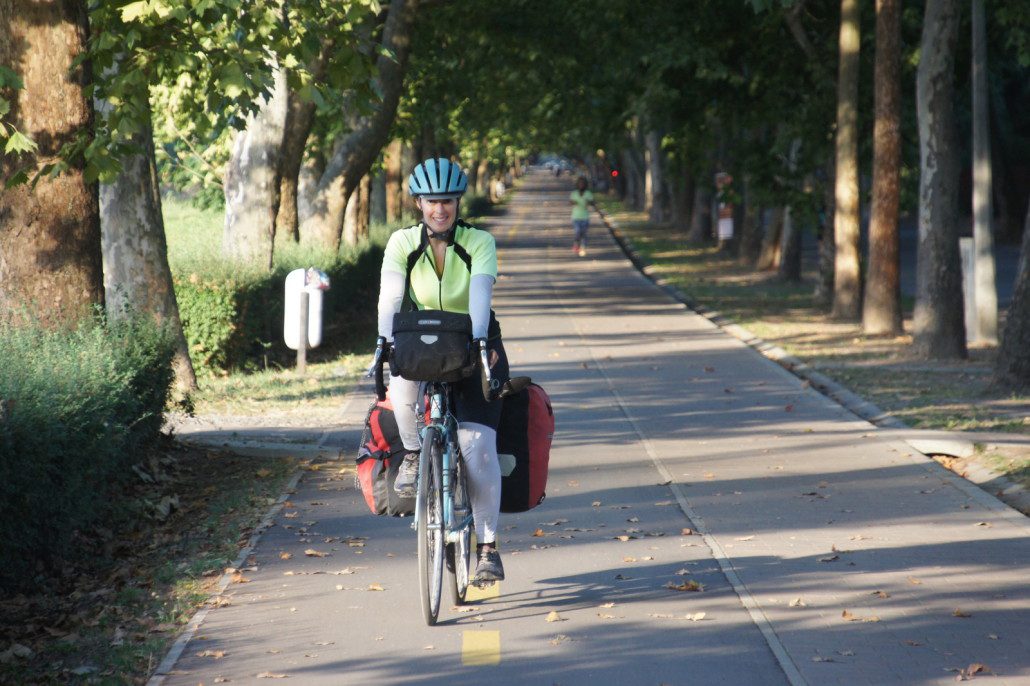Resources, Links and Apps for Bicycle Touring in Europe
Bicycle touring in Europe has something for everyone, with terrain ranging from flat, well-signed bike paths to mountains and the challenge of the Alps. After 3.5 months exploring by pedal power, I absolutely recommend a cycling trip here. Whether your trip is long or short, self-guided or with a company, there’s great times to be had for both newbies and seasoned cyclists.
Why? Logistics are easy, with frequent lodging, water, and food sources; it seems there’s town every 5 miles in most of Europe. Plus, businesses cater to cyclists. And if you’d like to skip certain areas, train routes are plentiful. Throw in the fun of varied languages and cuisine, tons of history, and beautiful architecture and it’s simply a fantastic cycling destination.
This post describes technology and online resources to help make your European bicycle tour a success. I also list each of the 13 countries we visited and link to my favorite cycling and lodging networks in each of them. Using my external brain in Evernote, I compiled and organized these as we traveled, which made sharing easy. Hopefully it saves you a ton of time!
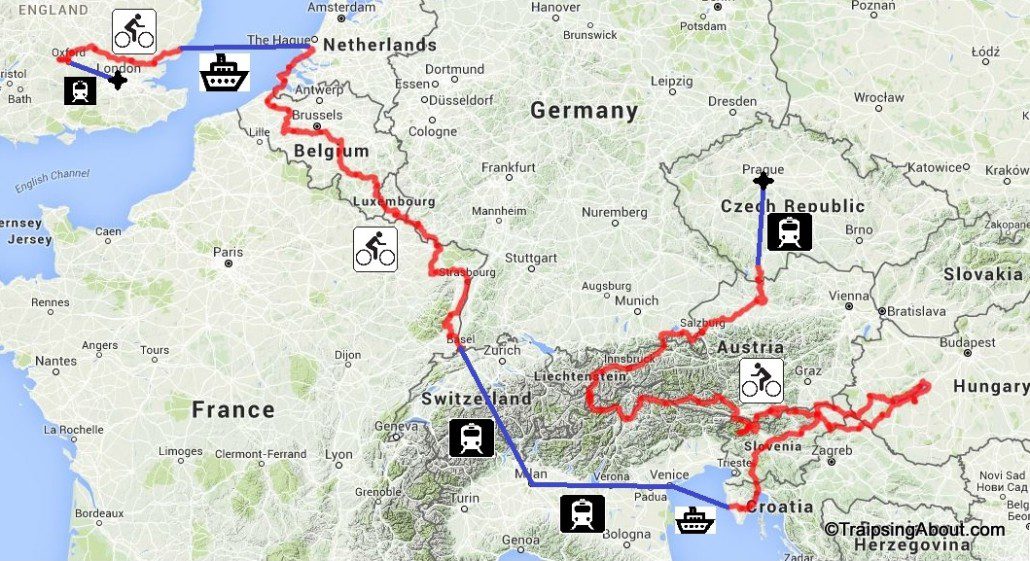
The route! Starting in London, we pedaled 2,500 miles, took a couple ferries, and hopped on a few trains.
Technology to Make Your Trip Easy
Given my love of technology, I’d be remiss to not start here. In fact, only one set of paper maps were harmed during our trip (it was in England, I confess). Otherwise, we didn’t use hard-copy maps at all.
“Real” maps weren’t necessary – really! And neither was a turn-by-turn GPS device; a smartphone loaded with the right apps made navigation a cinch. That said, the correct tool spells the difference between pedaling happily along versus pushing your bike through stinging nettles on a forgotten animal trail. (I did both, but prefer the former.) Below are specific tools that I used, and perhaps also read my post about tech details for traveling:
- Galileo Offline Maps – my go-to phone app for touring, Galileo pulls info from the Open Cycle Map database. I tried others (Long Haul Trekkers have a great list of offline navigation apps), but Galileo is my favorite. It costs just $2 and you can download individual countries (for free) as you need them. I toyed around with downloading .gpx routes into apps like Bike Hub from biroto.eu, but decided it wasn’t worth the hassle. If you use a GPS, perhaps it could help you out.
- ACSI – this app dials into the ACSI European database for 8,500 campgrounds that are inspected on a yearly basis (i.e. they don’t suck). You can buy individual country info or just snag the entire continent’s worth of data for $13.
- WifiMap – if you aren’t traveling with a hotspot or don’t have Google Fi service, this offline list of wifi hotspots and their passwords can come in quite handy, though the utility varies depending on the area because the info is crowdsourced.
- Warmshowers.org – this network of cyclists is a great resource for staying with local people. We used it frequently during our U.S. tour in 2014, but found it tougher to arrange in Europe with everyone on holiday. It’s definitely worth checking out! There’s a great app for it as well.
- Booking.com and AirBnb.com – after a long day of cycling where you don’t feel like camping (such as when it’s raining or 100 degrees outside), it can be nice to book a place and not search around at the end of the day. We used the Booking.com app mid-ride some days to nail down a place so we could land without having to search for lodging. It was our favorite since there isn’t any time-sucking back and forth communication with a host, but we used Airbnb probably 25% of the time, especially for longer stays in one place when we wanted a kitchen or a full apartment. I should note that Booking.com also has apartments in some locations.
- Google Maps – an oldie, but a goodie. Same as with Galileo, I’d save locations or map things before we left for the day. I tried voice navigation using ear buds initially, then decided it was unnecessary.
With the above, you’ll be fit as an Olympic marathoner for figuring out where you are, where you’re going, and where the heck you’re going to sleep. The pedaling is still up to you – I haven’t found an app for that. But now that you know how to find routes, which ones should you follow? Read on!
Dedicated Bike Routes, Cycle Paths, and Other Resources
We landed in London with no set route beyond a ticket out of Prague. That’s always our favorite method for exploring, though we knew of 14 EuroVelo cycle routes criss-crossing Europe like strands of a golden cycling spiderweb. Following those routes or regional networks, we spent many days on quiet country roads or bike paths, not to mention that many cities also had great cycle-only routes.
Compared to the United States, there are far more resources in Europe for bicycle touring. I used the below to plan:
- EuroVelo (EV) routes – the backbone of any route planning for a European cycling trip for those seeking to follow bike paths or cycle routes. The EV frequently follows local/regional maps (see below), but this overview is great for developing a general route plan.
- Updated October 19, 2017: Bikeroll.net looks like a great service to check out. I haven’t used it during a tour, but it looks clean and simple to use. Here’s the instructions for using it.
- OpenCycleMap.org – this compiles both the EV routes and regional maps to show low-traffic roads or bicycle paths. Most touring apps that I found pulled from this database.
- Bikemap.net – if Google Maps doesn’t have cycling options in the country (Italy, Hungary, Croatia, Slovenia, Czech Republic), this is a great option to scope out potential elevation profiles, such as this quad-tester from Sudtirol in Italy.
Regional Bike Routes in European Countries
The EuroVelo routes are great, but what if you want or need to deviate from those? Fear not – there are many local resources available. Here’s each of the 13 countries we visited and the resources I used to navigate, all arranged in alphabetical order:
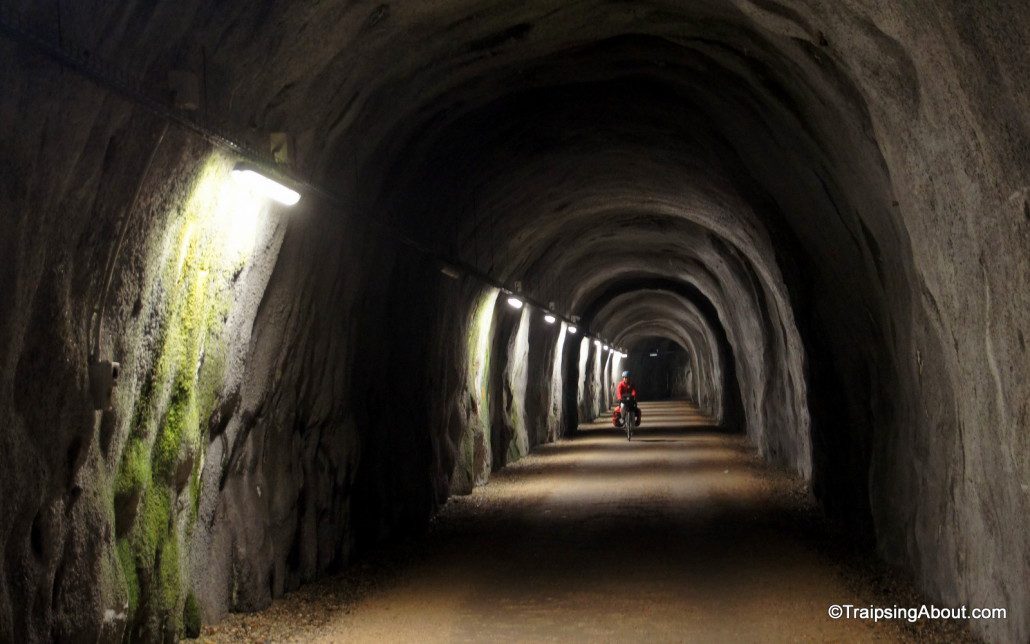
Many of the bike paths are old train lines, which means we rode through many cool tunnels like this.
- Austria – not only is the scenery fantastic, but it doesn’t get any better than Austria’s bike infrastructure. Clear signage, car-free paths, and even bike maintenance stops. The best part? The word for “bike” in German is RAD. North to south, the Alpe Adria route rocks through the Austrian Alps. East-west, try the mountain-cutting Inn River Path from Switzerland to Germany and the Drau Cycle Path from Italy to Hungary (we rode both of them). Or just check out all of the country’s paths.
- Belgium – you’ll need multiple resources here. First the Fiets Routes for the Dutch-speaking Flanders (northern Belgium), where we followed the famous Tour de Flanders. Then the southern, French-speaking part has two – RandoVelo and Ravel will help you through the famous WWII battle zone of the Belgian Ardennes. Fair warning that an 80k day will stack up 1000 meters of climbing in these steep hills. Here’s my post about our Belgian experience.
- Croatia – cycle routes here are more, shall we say, suggestions? Narrow, winding coastal roads with no shoulders and a few country roads for a breather. I recommend riding here in the shoulder seasons and getting up early to avoid traffic. It’s beautiful, but stressful riding. We joined two friends and their dog for this portion of the trip.
- Czech Republic – this country features an insane number of cycle routes. I can see why cycle touring is one of the favorite activities in this country, as routes are well-signed and typically follow quiet country roads. It holds a special place in our hearts since Chelsea and I met there in 2006.
- England – the National Cycle Network is the place to go for designing your cycle tour through Britain. We spent a week riding from Oxford east to the coast, and I’m looking forward to returning to explore the Lakes District up north.
- France – sorry, not much help here as we simply followed the EuroVelo 5 route through eastern France into the pretty Alsace wine region near Strausborg and Colmar. The super-popular EuroVelo 6 runs from France’s western edge straight east and is reportedly quite good.
- Germany – as you might expect, the Germans have cycle touring figured out. Their cycle network is solid, as is their list of accommodations (bike and bed, as they call it) for cyclists. We didn’t spend many days in Germany, but I found it easy to navigate.
- Hungary – the EuroVelo 6 is the most common way people ride through Hungary, which is predominantly farmland. We came in from Slovenia/Croatia and pedaled around Lake Balaton, which was…ok. The beautiful north side of the lake is the only part of the trip I’d recommend (here’s the blog post about our experience).
- Italy – we only cycled in the NE part of the country, the beautiful Sudtirol. These two resources laid out the routes nicely. A German traveler in England insisted we visit this place and described it as a combination of Austrian efficiency and Italian quality of life (all menus and signs are in both languages, which was interesting). He was right: go here. This was our favorite mix of scenery and silky cycle paths, most next to rivers through the Italian Dolomites. (Side note: the mountain biking here rocks. Check out the riding in Reschenpass, which starts in Italy, into Switzerland and Austria, and then back to Italy. First time I’ve been to three countries in one ride. Did I mention there are four gondolas that haul you and your bike uphill?)
- Luxembourg – this tiny speck of a country has a great cycling network both in the countryside and in the picturesque capital. And lots of steep hills.
- The Netherlands – all you need is Nederland Fietsland. Flat terrain, perfect cycle paths, and more e-bikes than you’ll see anywhere in the world, Holland is a cycling paradise. It also has a “friends of cyclists” network where locals host cyclists. According to my friends there, the downside is the terrible weather. Here’s my post about our time there.
- Slovenia – a favorite country from our trip, especially the NW portion in the Julian Alps. Nice people, laid-back cities, and varied, pretty landscapes made for a great time there. However, while Slovenia lauds its cycling, I couldn’t find a digital copy of their bike routes. Luckily, the Galileo app worked well.
- Switzerland – of course the Swiss have their cycle network totally dialed. We didn’t spend much time there, but look forward to coming back.
And that, my friends, is the logistics download for countries we visited during our European cycle tour. For countries not mentioned, I recommend simply Googling “country name + cycling network” to see if there’s a regional resource. It seems there usually is.
Europe has my vote as a great cycling destination. And we weren’t the only ones out there – I saw an incredible number of people of all ages using the excellent bike infrastructure. Don’t let the language barrier intimidate you either, as nearly everyone speaks English and people are very helpful. For your next trip there, leave the backpacks at home and try exploring on your bike. It’s an experience you won’t forget.
What resources, tools, apps or other intel do you have for anyone looking to cycle tour in Europe? This post is intended as a long-term resource that will build over time, so please add your thoughts in the comments or shoot me an email.
